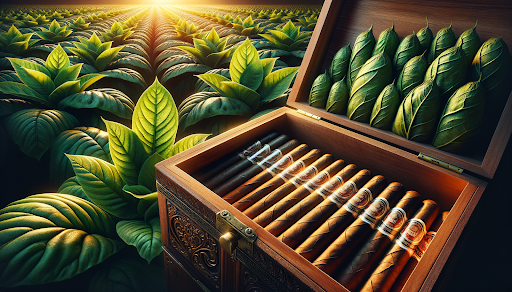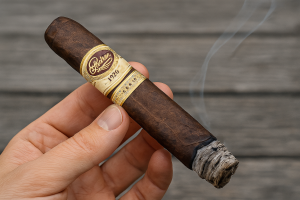What Are the Biological Processes Behind the Evolution of Cigar Flavor - A Look into the Science of Taste

Cigars are not merely rolled leaves of tobacco; they are complex products shaped by a series of biological processes that result in their unique flavors and aromas.
Understanding these processes not only enhances appreciation for cigars but also informs makers and consumers about the factors that influence flavor evolution.
This blog post delves into the biological mechanisms underpinning cigar flavor development, focusing on genetics, environmental factors, fermentation, and aging.
From Plant to Palate: The Process of Cigar Flavor Evolution Breakdown
The unique flavors of cigars result from a combination of biological and environmental influences. From the genetic makeup of tobacco plants to the soil and climate conditions where they’re grown, each factor plays a role in shaping distinct taste profiles.
Let’s dive into the fascinating science behind cigar flavor development, exploring how each stage contributes to the final taste.
1. Genetics of Tobacco Plants
- Varietal Influence: Different species and hybrid varieties of tobacco plants, such as Nicotiana tabacum and Nicotiana rustica, possess distinct genetic makeups that influence flavor profiles.
- Chemical Compounds: The genetic composition of the tobacco plant can affect the production of key phytochemicals, including alkaloids (like nicotine), terpenes, and flavonoids, which contribute to flavor and aroma.
- Flavor Notes: For instance, the Connecticut Broadleaf variety is known for its rich, sweet flavor, while Habano leaves are often described as earthy and spicy.
2. Environmental Factors
- Soil Composition: The type of soil in which tobacco is grown impacts nutrient availability and pH levels, affecting the plant’s chemical profiles.
- Climate Conditions: Temperature, humidity, and rainfall during growth play significant roles. For example, the sun-exposed leaves of Cuban tobacco often yield strong, robust flavors due to the tropical climate.
- Geographical Influence: Regions like the Dominican Republic, Nicaragua, and Honduras provide distinct terroirs, influencing the flavor characteristics of the tobacco grown there. Recent studies have shown that certain areas produce leaf varieties that are perceived as sweeter or more robust.
3. Fermentation Process
- Biochemical Changes: Fermentation involves microbial activity, leading to biochemical transformations that enhance flavor. During this process, sugars are broken down, resulting in the production of volatile compounds.
- Temperature and Humidity Control: Fermentation temperature and humidity significantly influence the effectiveness of these biochemical reactions. For instance, the fermentation of tobacco in controlled environments often leads to a smoother and more complex final product.
- Role of Microorganisms: Specific strains of mold and bacteria can either enhance or detract from flavors. Aspergillus oryzae, a common mold, has been linked with the production of desirable flavors during fermentation.
4. Aging of Cigars
- Chemical Evolution: Over time, the chemical compounds in cigars continue to evolve. Aging allows certain harsher notes to mellow while enhancing subtler flavors.
- Storage Conditions: Optimal aging occurs at controlled temperature and humidity levels, ideally around 70% humidity and 70°F (21°C). Cigar makers report improved flavor profiles with aging ranging from six months to several years.
- Real-World Examples: High-end brands such as Cohiba and Padron often leverage aging as a technique to develop their signature rich and layered flavors.
5. Consumer Experience
- Subjective Tasting Notes: Individual perception plays a substantial role in flavor experience. Factors such as personal palate and smoking technique can greatly influence how flavors are experienced.
- Recent Trends: Data from the Cigar Aficionado magazine has shown that cigar enthusiasts increasingly favor complex flavor profiles that combine sweet, spicy, and earthy notes.

Indulge in the Artistry of Iconic Cigar Brands
For aficionados who seek elegance in every puff, these premium brands offer unparalleled experiences.
- H. Upmann: Known for its smooth, creamy flavor with mild to medium strength, H. Upmann cigars offer subtle notes of cedar and coffee, ideal for a relaxed, refined smoke.
- Oliva: The Oliva brand is renowned for its full-bodied richness with notes of dark chocolate and espresso, offering a bold experience perfect for seasoned smokers.
- Davidoff: With a reputation for elegance, Davidoff cigars bring a sophisticated balance of earthy, floral, and spicy notes, making it a favorite for those seeking complex yet smooth flavors.
- Romeo y Julieta: Famous for its mild to medium profile, Romeo y Julieta cigars offer hints of cedar, nuts, and a slight sweetness, providing a classic and versatile option.
- My Father Cigars: Known for its bold, peppery flavors with rich undertones of cocoa and wood, My Father Cigars deliver a full-bodied experience appreciated by those who enjoy intensity and complexity.
Start Savoring Cigars Like a True Aficionado
Exploring the biological processes and environmental factors that shape cigar flavors deepens our appreciation for the artistry behind each cigar.
From genetics and soil composition to fermentation and aging, each stage adds unique complexity and character, ultimately influencing the taste and experience.
By understanding these elements, you can make more informed choices, selecting cigars that align with your preferences and create memorable smoking moments.
Main Takeaways:
- Understanding the biological processes behind cigar flavor evolution can enhance appreciation for this craft.
- For enthusiasts, exploring cigars from different regions or varieties can yield unique flavor experiences.
- Cigar makers should consider the impact of genetics, environmental factors, and fermentation techniques on their products.
- As the industry evolves, embracing sustainable and innovative practices while respecting traditional methods can present new opportunities for flavor exploration.















